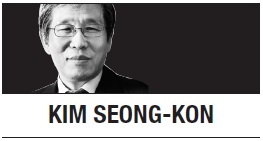[Kim Seong-kon] Be lost in Pastland or prosper in Tomorrowland?
By Kim Seong-konPublished : July 18, 2017 - 17:42
 If you ask a scientist, “What is a star?” he will probably answer, “It is a gigantic mass of dust located in the universe far away from Earth.” How unromantic! Yet it is the undeniable truth. In the eyes of a scientist a star is nothing but a round shaped mass of dust, earth and rocks orbiting in the universe in the dark.
If you ask a scientist, “What is a star?” he will probably answer, “It is a gigantic mass of dust located in the universe far away from Earth.” How unromantic! Yet it is the undeniable truth. In the eyes of a scientist a star is nothing but a round shaped mass of dust, earth and rocks orbiting in the universe in the dark. However, if you asked the same question to a poet or a student of literature or the humanities, the answer would be totally different. He will describe a star as the most gorgeous object he can dream of. And he will use all sorts of romantic words related to stars, such as rising star, shooting star, star-crossed lovers, stardust sky, starry, stellar, and movie star.
To a certain extent, it is a matter of reality and fantasy. Scientists observe reality through telescopes and microscopes, whereas writers tend to fantasize. If you fantasize, you do not see the real person or real object. Instead, you only see the beauty created by your fantasy, which is far from reality. However, if you focus only on reality, you will never be able to see the beauty in it. In that sense, it is like the two sides of a coin.
At the same time, it could be a matter of distance as well. That is to say, at a distance, you will find a star exquisite and gorgeous because you gain perspective. In a close range, however, even a star may look ugly and grotesque. While explaining his own literary theory of distance, Jacques Derrida said that a woman may look more beautiful and mysterious at a distance. So does a man. If you are too close for comfort, you may find undesirable things and shortcomings of the person or thing you see. Telescopes and microscopes are the devices that reduce the distance between our eyes and the objects we want to see.
When I lived in the States, I felt my vision, which had been 20/20, gradually deteriorating as I spent my days reading books in the university library. I went to a doctor’s office to get a pair of prescribed glasses. When I wore the glasses for the first time in my life, the whole world looked different. I could see everything so clearly. For example, I could see all the freckles on the nurse’s face. In a sense, the corrective lenses reduced the metaphorical distance between my eyes and the nurse.
Likewise, even a beautiful twinkling, shiny star may not be pretty if you see it in a short range. Perhaps all you can find is a gigantic dark globe made of dust, merely reflecting light from the sun. A star is beautiful only when you dream of it or fantasize it at a distance. Reality and truth can be uncomfortable and ugly sometimes. Perhaps that is why we need poetry, fiction, songs, and dreams. Otherwise, life will be too gloomy, desolate, and bleak.
In his monumental book, “The Interpretation of Dreams,” Freud argues that our dreams reflect our unconsciousness called “Id” that is formed by what has happened in the past. Despite Freud’s scientific explanations, many romantic people want to believe that dreams are prophesying our future or a wish-fulfillment. Indeed, the lyrics of a Christmas carol go, “I’m dreaming of a white Christmas.” We also say, “My dream is to become a doctor,” or “You are my dream girl.” At school, we teach our students to dream for a bright future. Indeed, we need to dream on, even though the reality is harsh and miserable.
In that sense, our new government should implement committees on building a bright future, rather than on investigating the dark past. If we cling to the past, we will not be able to dream of the future. Besides, we do not have the luxury of spending time and energy digging out skeletons in the closet. Instead, we should unite and concentrate our time and energy on making a better future. You cannot change the past, but you can change the future. If we cannot get over past specters, we will not be able to move forward. Then our future will be as gloomy as our dark past was.
The recent movie, “Tomorrowland,” implies that as long as there are dreamers on Earth, we can avoid total annihilation and have a bright future. At the end of the movie, dreamers in different countries find campaign pins inscribed with T, which stands for “Tomorrowland.” We, too, should strive to find our “Tomorrowland.” It would be unwise and miserable if we were helplessly lost in “Pastland,” while other nations found “Tomorrowland” already.
If we are stuck in the dark past, all we can see will be the ugly mass of dust. If we move forward, we will surely see beautiful stars shining in the night sky. The choice is ours.
By Kim Seong-kon
Kim Seong-kon is a professor emeritus of English at Seoul National University and president of the Literature Translation Institute of Korea. He can be reached at sukim@snu.ac.kr. -- Ed.


![[AtoZ into Korean mind] Humor in Korea: Navigating the line between what's funny and not](http://res.heraldm.com/phpwas/restmb_idxmake.php?idx=644&simg=/content/image/2024/04/22/20240422050642_0.jpg&u=)
![[Exclusive] Korean military set to ban iPhones over 'security' concerns](http://res.heraldm.com/phpwas/restmb_idxmake.php?idx=644&simg=/content/image/2024/04/23/20240423050599_0.jpg&u=20240423183955)


![[Herald Interview] Why Toss invited hackers to penetrate its system](http://res.heraldm.com/phpwas/restmb_idxmake.php?idx=644&simg=/content/image/2024/04/22/20240422050569_0.jpg&u=20240422150649)
![[Graphic News] 77% of young Koreans still financially dependent](http://res.heraldm.com/phpwas/restmb_idxmake.php?idx=644&simg=/content/image/2024/04/22/20240422050762_0.gif&u=)






![[Exclusive] Korean military to ban iPhones over security issues](http://res.heraldm.com/phpwas/restmb_idxmake.php?idx=652&simg=/content/image/2024/04/23/20240423050599_0.jpg&u=20240423183955)



![[Today’s K-pop] Ateez confirms US tour details](http://res.heraldm.com/phpwas/restmb_idxmake.php?idx=642&simg=/content/image/2024/04/23/20240423050700_0.jpg&u=)